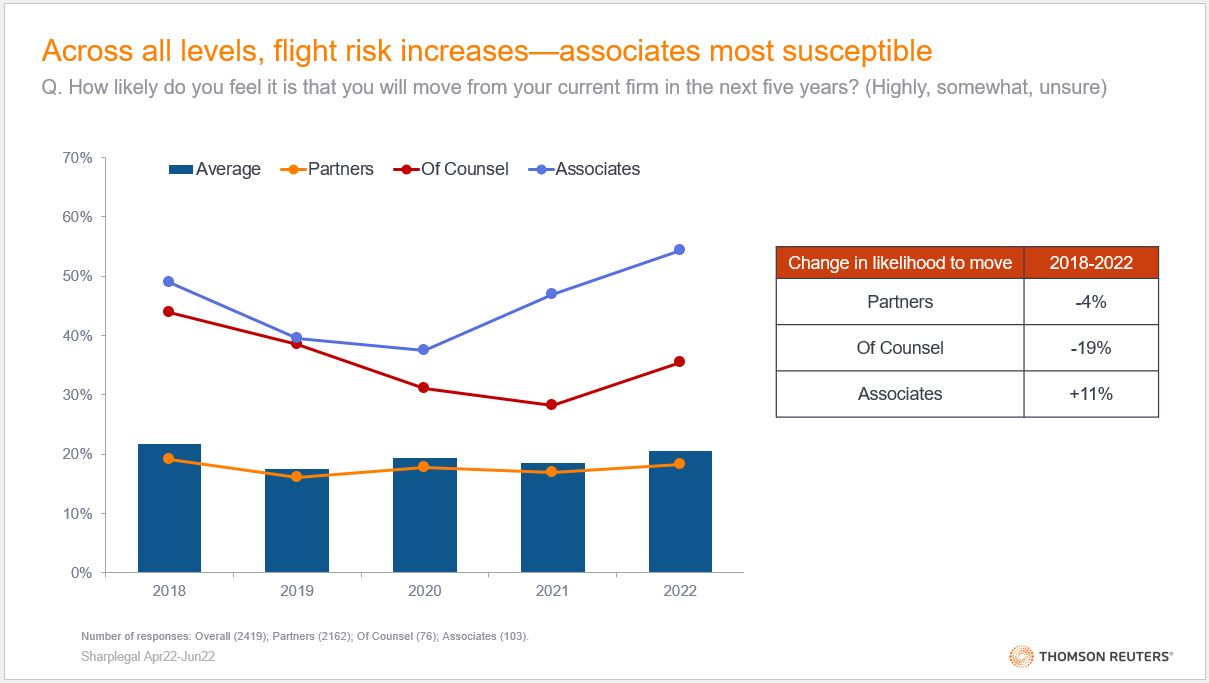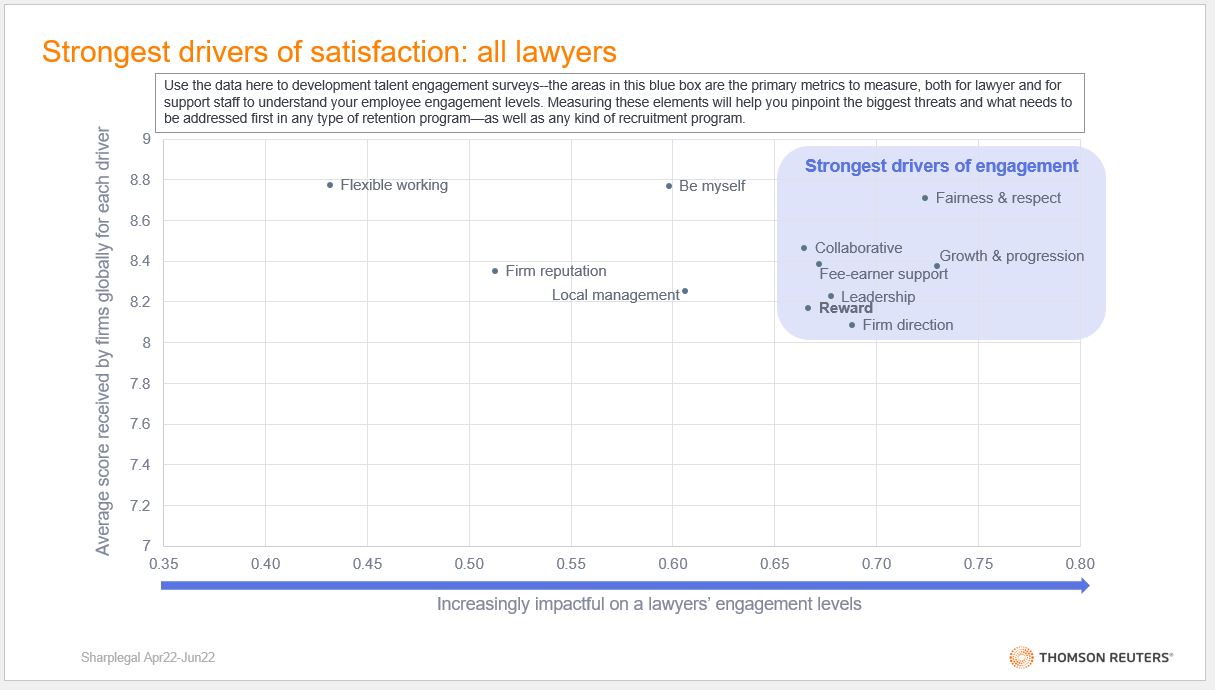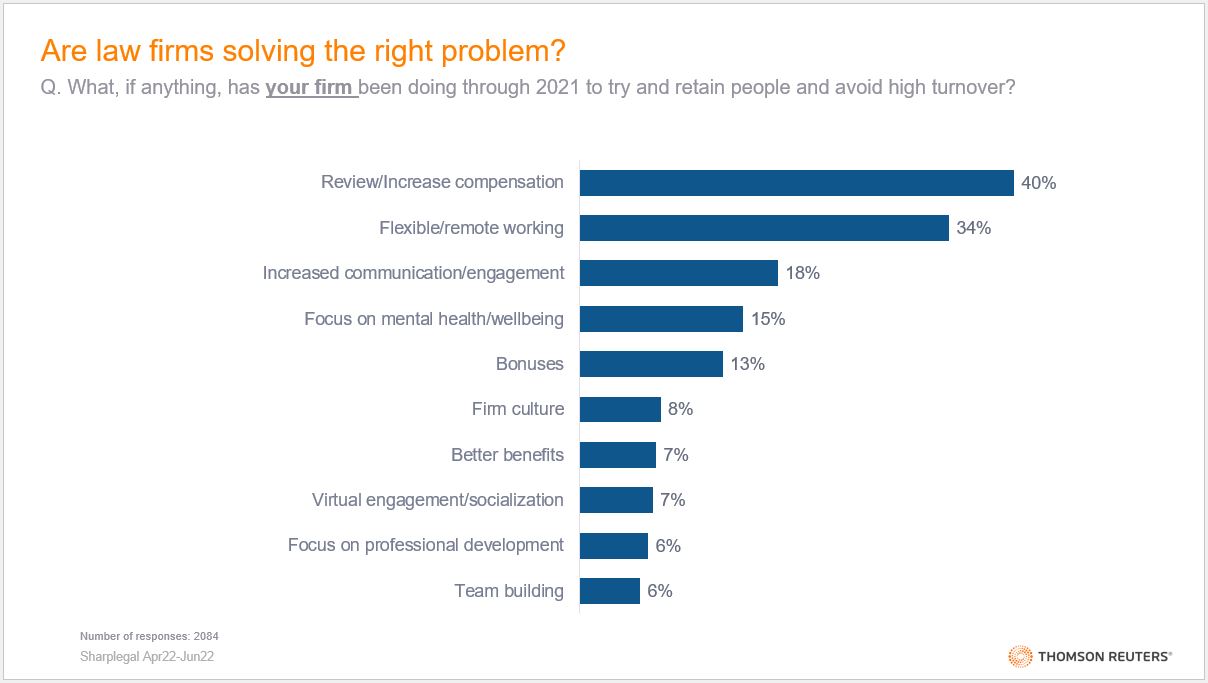How can law firms best create an atmosphere of engagement and loyalty for their top lawyers and battle back against flight risk? Hint: It's not all about compensation
The war for talent has been written about extensively — even on the Thomson Reuters Institute. Still, one fact tends to be overlooked in the recent flurry of reporting on legal talent trends: Legal talent attrition is not a new phenomenon resulting from The Great Resignation. It is consistently an area where law firms have struggled.
At any given moment, roughly 20% of law firm partners consider themselves to be a flight risk; and that number grows when you add in Of Counsel and Associates. Further, this level of flight risk exists in good economic times and bad. The below chart shows how flight risk has changed over the last five years.
Yet, even in 2020 as market uncertainty was at a peak, there was not the significant reduction in flight risk levels one would expect. The longer-term perspective shows, despite an uptick in flight risk over the last two years among Associates and Of Counsel, there is little substantial variance over time.

All this points to a strong conclusion: Many law firms have not cracked the code of how to keep lawyers engaged and loyal to a single firm. The only change is now the industry is talking about the problem.
A single-focus approach to retention undermines the end goal
It’s tempting to blame lawyer attrition on the biggest elephant in the room — compensation. A few brave law firms have even started to point to lawyers’ work-life balance as a driver of attrition. However, if giving people more money and flexibility was truly the answer, you wouldn’t be reading this article. As with most topics involving people’s internal motivation, there’s a lot more that goes into building talent engagement and loyalty.
And to further complicate the issue, our data shows that what people say they want, isn’t always reflected in their actual behavior.
For example, if you ask lawyers what factors might make them consider leaving their current firm, the top answer is compensation, and this is particularly true when you zero in on Associates. Yet, the data suggests compensation doesn’t even sit within the Top 5 drivers of lawyer satisfaction — a commonly used metric for how likely a lawyer will stay at their current firm.
The below chart depicts a correlation analysis of which factors are more (or less) strongly correlated to lawyer satisfaction. The further to the right on the chart a factor sits, the more strongly correlated it is to lawyer satisfaction.

The attribute most strongly correlated with lawyer satisfaction is Opportunities for Growth and Progression. Without devolving into a full-blown statistics dissertation, this essentially means that lawyers reporting high levels of satisfaction tend to have high satisfaction with the opportunities for growth and progression offered at their firms. Equally, those lawyers with lower satisfaction tend to rate this area lower than others.
The other factors with strong levels of correlation to lawyer satisfaction include:
-
-
- being treated with fairness and respect;
- the firm’s overall direction and strategy;
- confidence in the leadership of the firm; and
- support received from other fee-earners.
-
Only after these factors, does compensation and reward enter the chart.
Naturally, compensation has its place in talent satisfaction and retention; however, the data suggests that if firms don’t also address the other core drivers of engagement, the underlying issues causing attrition are likely to remain.
Thus far, this is where most law firms have fallen short.
When asked what their firms are doing to combat attrition, most lawyers point to compensation and work flexibility as the top tactics. After these two solutions, there is a lot less consistency in what firms are doing differently than they were before. Indeed, less than 20% of lawyers mentioned that their firms engaged in tactics like increasing communication from leadership or focusing on helping lawyers navigate their career development.
However, if we go back to the correlation chart above, we see that these two tactics are less impactful in building a more engaged lawyer talent base. In fact, flexible working has the weakest correlation to lawyer satisfaction out of the activities tested. (As a side note: The reason for this is not that lawyers are not interested in flexible working. Rather, lawyers who are satisfied and lawyers who are not satisfied at their current firms are showing similar levels of satisfaction with their firm’s approach to flexible working. Hence, this is not an area where we see variability among the different lawyer groups.)

If you build it, will they stay?
The good news is that the factors that drive lawyer engagement are clear and distinct; but are firms willing to change the way they have traditionally handled talent to get at these root causes of attrition?
For some firms, the answer is decidedly yes. Discussions as part of Thomson Reuters Institute’s roundtables with Managing Partners, Chief Talent Officers, and Chief Marketing Officers have shown that law firms are beginning to tackle a new approach to talent management. Some of these new strategies include:
Taking a more hands-on approach to career development — As discussed earlier, the attribute most strongly correlated with lawyer satisfaction is Opportunities for Growth & Progression.
To this end, a number of firms have employed full-time career counselors to help lawyers navigate through the different options that are available to them within the firm. These counselors spend time talking through what a lawyer is looking to get out of their career and providing them with connections within the firm that they may not have been aware of or knew how to tap into.
Conducting “stay” interviews — A common challenge voiced by Managing Partners in particular is that they don’t even know a lawyer is unhappy until the lawyer turns in their notice, and they are then conducting an exit interview. Of course, then it is simply too late to do anything about the situation.
A number of firms have embraced the practice of stay interviews — checking in with lawyers using a short, but well-curated list of questions to better understand what keeps their lawyers motivated and what may have them looking elsewhere.
Providing more guidance to the direct line managers — One of the biggest challenges for firms (or for any organization, really) is making sure that the day-to-day managers are also delivering the same big-picture messages to those peoples who report to them. For most firms, this is a challenge as (traditionally) fee earners are also people leaders, and both roles require a high-level of effort to execute successfully.
A few firms are tackling this directly and making sure the partners responsible for practices or industries execute certain tasks, such as i) talking about career opportunities; ii) building clear paths for success, whether that’s partnership or an alternative; and iii) articulating the firm’s strategy in a way that helps every employee understand their role in the success of the firm.
While flight risk in the legal industry is not a new phenomenon, it is under the microscope. How firms respond to the growing conversation around what their legal talent wants will determine if the needle can be moved toward lower levels of attrition.
You can learn more about how you can use market intelligence to enhance your firm’s talent management strategies here.







